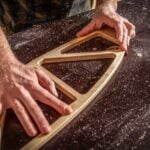Are you wondering how to get black stains off white woodwork? It can be frustrating to discover unsightly black marks on your pristine white woodwork, but fear not, as we have some effective solutions for you. Black stains on white woodwork can ruin the aesthetic appeal of your home and it’s important to address the issue promptly.
In this article, we will delve into the causes of these pesky stains and provide you with practical step-by-step guides on how to remove them using natural remedies and chemical cleaners. Additionally, we’ll share valuable tips for preventing black stains in the future and alternative methods for tackling stubborn stains. By the end of this article, you’ll be equipped with the knowledge to effectively maintain the cleanliness and appearance of your white woodwork.
Black stains on white woodwork can be a result of various factors such as water damage, mold growth, or even chemical reactions from certain household products. It’s essential to identify the root cause of these stains in order to effectively remove them and prevent their recurrence. By understanding the problem at hand, you’ll be better equipped to choose the right approach for removing black stains from your white woodwork.
Before embarking on your stain removal journey, it’s crucial to gather all necessary materials and tools. Whether you opt for natural remedies or chemical cleaners, having the right supplies at hand will make the process much smoother.
From common household items like vinegar and baking soda to specialized cleaning products, preparing ahead of time will save you from unnecessary stress during the removal process. Keep reading to learn about effective ways to banish those stubborn black stains from your beautiful white woodwork.
Identifying the Causes of Black Stains on White Woodwork
Black stains on white woodwork can be a frustrating and unsightly problem for homeowners. Understanding the causes of these black stains is essential in order to effectively remove them and prevent future occurrences.
Moisture and Mold
One common cause of black stains on white woodwork is moisture and mold. When wood is exposed to high levels of moisture, whether from a leak or high humidity, it can create the perfect environment for mold to grow. This mold can then result in black stains on the woodwork, which can be difficult to remove if left untreated.
Chemical Reactions
Another cause of black stains on white woodwork is chemical reactions, which can occur when certain substances come into contact with the wood. For example, metal fittings or hardware that are not properly sealed or coated can leave behind black marks on the wood due to oxidation or corrosion.
Aging and Wear
Over time, natural wear and aging of the woodwork can also lead to the development of black stains. As paint or sealant begins to break down, it can allow dirt and grime to penetrate the surface of the wood, resulting in dark discoloration that is difficult to remove.
Understanding these causes will enable homeowners to take appropriate measures in removing and preventing future black stains on their white woodwork. By addressing these underlying issues, homeowners can ensure that their woodwork remains clean and free from unsightly black marks.
Preparing the Necessary Materials for Removing Black Stains
When it comes to removing black stains from white woodwork, it is essential to gather the necessary materials beforehand to ensure a successful cleaning process. By using the right tools and products, you can effectively get rid of stubborn black stains and restore the pristine appearance of your white woodwork. In this section, we will discuss the essential materials needed for removing black stains and how to prepare them for use.
Natural Remedies
For those who prefer natural remedies, some common household items can be used to remove black stains from white woodwork. You will need materials such as white vinegar, baking soda, lemon juice, and olive oil. These natural ingredients are not only effective in removing stains but also safe for the environment and your health.
Chemical Cleaners
If natural remedies do not yield the desired results, chemical cleaners can be used to tackle tough black stains on white woodwork. Look for a reputable wood cleaner that is specifically formulated to remove stains without damaging the wood finish. Additionally, consider using a mild abrasive sponge or cloth to aid in the cleaning process.
Protective Gear
Before embarking on the stain removal process, it is crucial to prioritize safety by wearing protective gear such as gloves and goggles. This is especially important when working with chemical cleaners, as they may contain ingredients that can irritate the skin or eyes. Always read the labels on your cleaning products and follow safety precautions accordingly.
By ensuring that you have all the necessary materials prepared for removing black stains from white woodwork, you can effectively tackle this common issue with confidence and achieve professional-looking results.
Step-by-Step Guide on Removing Black Stains From White Woodwork Using Natural Remedies
Black stains on white woodwork can be a frustrating and unsightly problem, but there are several natural remedies that can effectively remove these stains. One of the most common causes of black stains on white woodwork is mold and mildew, which thrive in damp and humid conditions. These fungi can leave behind black spots or streaks on the surface of the wood, creating an unattractive appearance.
To remove black stains from white woodwork using natural remedies, you will need a few common household items. White vinegar, baking soda, lemon juice, and hydrogen peroxide are all effective natural cleaners that can help eliminate black stains from wood surfaces without causing any damage.
First, mix equal parts white vinegar and water in a spray bottle and apply the solution to the affected area. Let it sit for a few minutes before scrubbing the stain with a soft-bristled brush or cloth.
For more stubborn stains, create a paste using baking soda and water, apply it to the affected area, and scrub gently. Another option is to use lemon juice or hydrogen peroxide by applying them directly to the stain and allowing them to sit for a few minutes before wiping clean.
Using these natural remedies not only helps in removing black stains from white woodwork but also ensures that no harsh chemicals are being used, making it safer for both your health and the environment.
| Common Natural Cleaners | Effectiveness |
|---|---|
| White vinegar | Effective for light to moderate stains |
| Baking soda | Great for stubborn stains |
| Lemon juice/hydrogen peroxide | Natural bleaching agents – effective on tough stains |
Step-by-Step Guide on Removing Black Stains From White Woodwork Using Chemical Cleaners
Black stains on white woodwork can be stubborn and difficult to remove, but with the right techniques and materials, it is possible to restore the pristine appearance of your woodwork. In this section, we will provide a step-by-step guide on how to remove black stains from white woodwork using chemical cleaners.
1. Prepare the Area: Before applying any chemical cleaners, it’s important to prepare the area. Make sure to cover the surrounding flooring or furniture with protective materials such as plastic sheeting or old towels to prevent any damage from the cleaning solution.
2. Choose the Right Cleaner: There are several different types of chemical cleaners available for removing black stains from white woodwork, including commercial stain removers, bleach-based products, or oxalic acid solutions. Be sure to read and follow the instructions on the cleaner carefully.
3. Apply the Cleaner: Using a clean cloth or sponge, apply the chosen chemical cleaner directly onto the black stain. Ensure that you wear gloves and eye protection when working with these cleaners to avoid any skin or eye irritation.
4. Scrub and Rinse: Gently scrub the affected area with a soft-bristled brush or sponge in a circular motion. Allow the cleaner to sit for a few minutes before rinsing it off with clean water. Be careful not to oversaturate the wood as excess moisture can cause damage.
5. Repeat if Necessary: Depending on the severity of the stain, you may need to repeat this process multiple times until the black stain is completely removed.
By following these steps and using appropriate chemical cleaners, you can effectively remove black stains from white woodwork and restore its original appearance.
Remember that while chemical cleaners can be effective for removing black stains from white woodwork, it’s important to use them properly and safely. Always test any cleaner in an inconspicuous area first before applying it to the entire stained surface How To Get Black Stain Off White Woodwork.
Tips for Preventing Black Stains on White Woodwork in the Future
Black stains on white woodwork can be a real headache to deal with, but there are ways to prevent them from occurring in the future. Whether you’ve just removed black stains from your white woodwork or you’re hoping to avoid dealing with them altogether, it’s important to take steps to keep your woodwork looking clean and pristine. Here are some tips for preventing black stains on white woodwork:
1. Keep your woodwork dry: Moisture can lead to the growth of mold and mildew, which can cause black stains on white woodwork. Be diligent about wiping up any spills or leaks promptly, and ensure proper ventilation in areas where moisture may accumulate.
2. Seal or paint your woodwork: Adding a protective seal or coat of paint to your white woodwork can help prevent black stains from setting in. This creates a barrier that makes it more difficult for mold, mildew, and other substances to penetrate the surface of the wood.
3. Regular cleaning and maintenance: Keeping your white woodwork clean is key to preventing black stains. Regular dusting and wiping down surfaces with a gentle cleaner can help remove any potential sources of staining before they become a problem.
Following these tips can help maintain the cleanliness and appearance of your white woodwork, keeping it free from unsightly black stains.
| Tips | Details |
|---|---|
| Keep Woodwork Dry | Wipe up spills promptly, ensure proper ventilation |
| Seal or Paint Woodwork | Add protective seal or coat of paint as a barrier |
| Regular Cleaning and Maintenance | Regular dusting and wiping down surfaces with a gentle cleaner |
Alternative Methods for Tackling Stubborn Black Stains on White Woodwork
If natural remedies and chemical cleaners have not been successful in removing stubborn black stains from white woodwork, there are alternative methods that you can try. These methods may require a bit more effort, but they can be effective in getting rid of the most persistent black stains. Here are some alternative methods for tackling stubborn black stains on white woodwork:
- Sanding: If the black stain has deeply penetrated the wood, sanding may be necessary to remove it completely. Start with a coarse grit sandpaper to remove the surface layer of the stained wood, then gradually move to finer grits to smooth out the surface.
- Bleaching: Using a wood bleach can help lighten or remove black stains on white woodwork. Follow the instructions on the product carefully, as different types of bleach may have varying application methods.
- Heat gun: A heat gun can be used to strip off layers of finish and stain from the wood. This method requires caution and precision to avoid damaging the woodwork.
These alternative methods may require careful handling and patience, but they can be effective in tackling stubborn black stains on white woodwork. It is important to exercise caution when using these methods to avoid causing damage to the wood. Always test any method in an inconspicuous area first before applying it to the entire surface.
It is important to keep in mind that prevention is key when it comes to maintaining white woodwork free from black stains. Regular cleaning and maintenance can help prevent future staining issues. However, if all else fails and stubborn stains persist, consulting a professional may be necessary for more advanced restoration techniques.
Conclusion
In conclusion, maintaining the cleanliness and appearance of white woodwork is essential for preserving its beauty and longevity. Black stains can be a nuisance, but with the right knowledge and tools, they can be effectively removed. Whether using natural remedies or chemical cleaners, it is important to take the necessary precautions and follow a systematic approach to ensure that the black stains are completely eliminated without causing damage to the woodwork.
By identifying the causes of black stains on white woodwork, homeowners can take proactive measures to prevent their recurrence in the future. Regular cleaning and maintenance, as well as using protective finishes, can help in preserving the pristine look of white woodwork. Additionally, being aware of alternative methods for tackling stubborn black stains provides reassurance that there are multiple options available for addressing this issue.
For those wondering how to get black stain off white woodwork, it’s important to remember that patience and persistence are key. With the proper knowledge and resources at hand, anyone can successfully restore the beauty of their white woodwork. By following these guidelines and taking preventative measures, homeowners can enjoy clean and flawless white woodwork for years to come.
Frequently Asked Questions
How Do You Get Black Stains Out of White Wood?
To get black stains out of white wood, you can start by lightly sanding the stained area to remove the surface layer. Then, apply a wood bleach or oxalic acid solution to lighten or remove the remaining stain.
How Do You Remove Black Wood Stain From Wood?
Removing black wood stain from wood involves using a chemical wood stripper to break down the stain and then scraping or sanding off the affected layers of wood. After that, you can apply a new wood stain to match the original color.
How Do You Remove Black Ring Marks From Wood?
Black ring marks on wood, typically caused by water damage, can be removed by gently rubbing the affected area with a mixture of toothpaste and baking soda. For more stubborn marks, try using a commercial wood cleaner or fine steel wool. Remember to refinish the affected area afterwards to restore its appearance.

Hi everyone! I’m a woodworker and blogger, and this is my woodworking blog. In my blog, I share tips and tricks for woodworkers of all skill levels, as well as project ideas that you can try yourself.





